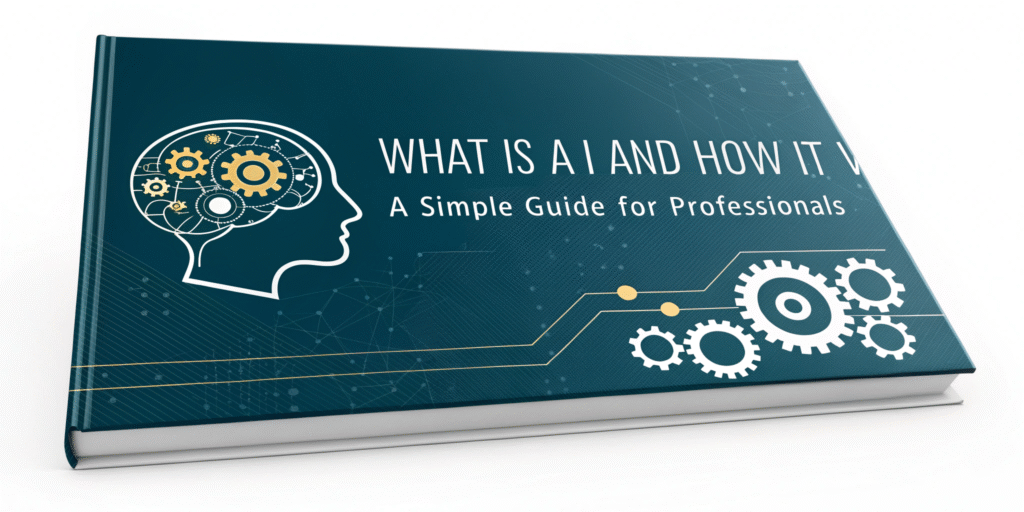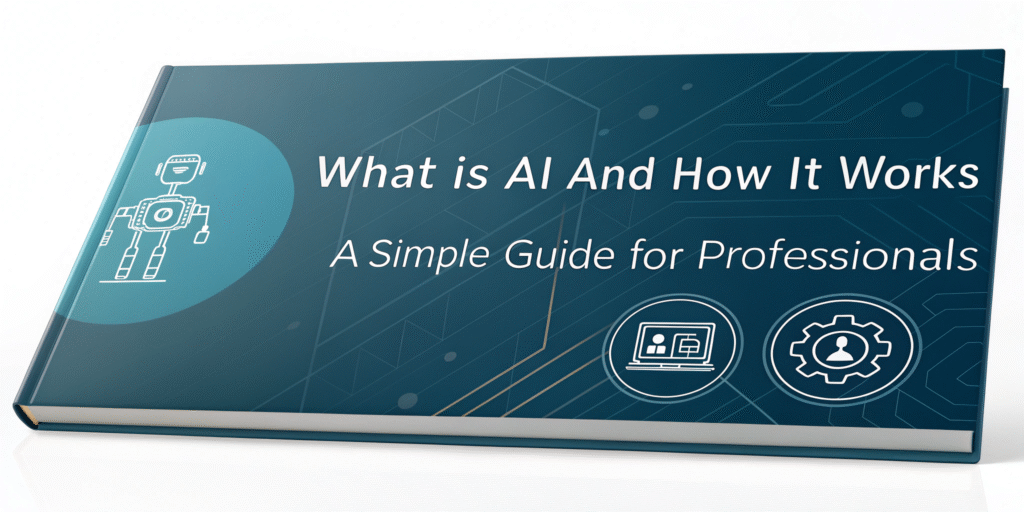
Introduction
If you’ve ever wondered how Netflix knows your next binge-watch or how your phone unlocks with a glance, you’ve encountered artificial intelligence (AI). But what is AI and how it works remains a mystery to many. For entrepreneurs, marketers, and content creators, moving beyond the buzzwords to a practical understanding is crucial. This guide will demystify the core concepts, breaking down the mechanics of AI in an accessible way. We’ll start by defining AI and then delve into the fascinating processes that make intelligent machines possible, empowering you to harness this technology for your business.
Table of Contents
- The History & Evolution of AI
- Who Benefits from Understanding AI? Audience & Demographics
- Key Features & Functions: Breaking Down How AI Works
- Business & Marketing Potential of AI
- Best Practices & Tips for Implementing AI
- Challenges & Limitations of AI
- The Future Outlook of AI
- Conclusion
The History & Evolution of AI
The quest to create intelligent machines isn’t new, but the formal field of AI began in 1956 at the Dartmouth Conference. Early researchers were wildly optimistic, believing a machine as smart as a human was just a summer project away. Reality, however, proved more complex.
AI’s history is a tale of peaks and valleys:
- 1950s-70s: The Birth and First AI Winter. Early programs could solve logic puzzles, but limitations in computing power and data led to disillusionment and reduced funding.
- 1980s: Expert Systems Rise. AI found commercial use with “expert systems” that codified human knowledge for specific tasks, like diagnosing diseases. However, they were brittle and couldn’t learn.
- 1990s-2000s: The Data Revolution. The internet explosion provided vast datasets. This era saw the rise of machine learning, where algorithms began learning from data patterns instead of relying solely on pre-programmed rules.
- 2010s-Present: The Deep Learning Boom. Powered by powerful computer chips (GPUs) and big data, deep learning algorithms achieved human-level performance in areas like image and speech recognition, leading to the AI renaissance we see today.
Who Benefits from Understanding AI? Audience & Demographics
Grasping what is AI and how it works is particularly valuable for specific roles that drive innovation and growth:
- Entrepreneurs & Executives: To make strategic decisions about investing in AI, identifying automation opportunities, and steering their companies through digital transformation.
- Marketers: To leverage AI for customer insights, personalized advertising, chatbots, and predictive analytics that boost campaign performance.
- Content Creators: To utilize AI tools for brainstorming, drafting, designing, and optimizing content efficiently.
- Product Managers: To integrate AI features like recommendation engines or voice assistants into products, enhancing user experience.
- Essentially, any forward-thinking professional who wants to stay relevant in a technology-driven economy.
Key Features & Functions: Breaking Down How AI Works
To truly understand what is AI and how it works, we need to look under the hood. At its simplest, AI is a broad field focused on creating machines that can perform tasks that typically require human intelligence. The “how” involves several layered concepts.
What is Artificial Intelligence?
Artificial Intelligence is the overarching science of creating intelligent agents—systems that can perceive their environment, reason about it, and take actions to achieve specific goals. This includes everything from a simple chess-playing program to a complex self-driving car.
How Does Machine Learning Power AI?
Most modern AI is built on Machine Learning (ML), a subset where algorithms learn from data. Instead of being explicitly programmed with rules, an ML model is trained. For instance, to create a spam filter, you don’t code rules like “if an email has ‘free money’ it’s spam.” Instead, you feed the algorithm thousands of emails labeled “spam” or “not spam.” The model identifies patterns on its own, learning what spam looks like.
Key ML types include:
- Supervised Learning: The model learns from labeled data (e.g., learning to classify images of cats and dogs from a tagged dataset).
- Unsupervised Learning: The model finds hidden patterns in data without labels (e.g., grouping customers into segments based on purchasing behavior).
The Role of Deep Learning and Neural Networks
Deep Learning is a powerful subset of ML inspired by the human brain. It uses Artificial Neural Networks (ANNs)—layers of interconnected nodes (“neurons”). Each layer processes information and passes it to the next, extracting progressively more complex features.
- How a Neural Network Learns: Imagine teaching a network to recognize a cat. The first layer might identify edges, the next combines edges into shapes, and a deeper layer recognizes patterns like eyes and fur. Through a process called “training,” the network adjusts the weights of connections between neurons to minimize errors, getting better with each example.
- This technology enables:
- Natural Language Processing (NLP): Allowing machines to understand and generate human language (e.g., chatbots, translators).
- Computer Vision: Enabling machines to interpret visual information (e.g., facial recognition, medical image analysis).
Generative AI: The Creative Frontier
Generative AI is a breakthrough application of deep learning. These models learn the underlying patterns in a dataset (like all text on the internet) and use that knowledge to generate brand-new, original content that resembles the training data. This is how tools like ChatGPT (for text) and DALL-E (for images) work.
Business & Marketing Potential of AI
Understanding what is AI and how it works unlocks immense practical value. Here’s how businesses are applying it:
- Hyper-Personalization: AI algorithms analyze user data to deliver tailored product recommendations, content, and marketing messages, significantly boosting engagement and sales.
- Operational Efficiency: Automate repetitive tasks like data entry, invoice processing, and customer service inquiries, freeing up human talent for strategic work.
- Data-Driven Insights: AI can process vast amounts of data to identify trends, predict customer behavior, and optimize supply chains, leading to smarter business decisions.
- Enhanced Customer Support: AI-powered chatbots provide instant, 24/7 support, handling common questions and routing complex issues to human agents.
- Content and Creative Acceleration: Generative AI assists in drafting articles, creating social media posts, and even generating marketing copy and visuals, speeding up production cycles.
Best Practices & Tips for Implementing AI
To successfully integrate AI, follow these guidelines:
- Start with a Clear Business Problem. Don’t adopt AI for its own sake. Identify a specific pain point, such as “reducing customer churn” or “speeding up content creation,” and find an AI solution that addresses it.
- Prioritize Data Quality. AI models are data-hungry. Garbage in, garbage out. Ensure your data is accurate, clean, and representative to train effective models.
- Run Focused Pilot Projects. Begin with a small-scale, well-defined project to demonstrate value, learn from mistakes, and build internal support before scaling up.
- Invest in People, Not Just Technology. Upskill your team to work alongside AI tools. The combination of human creativity and AI efficiency is powerful.
- Maintain Ethical Standards. Be proactive about addressing AI bias and ensuring transparency. Audit your AI systems to ensure they are fair and explainable.
Challenges & Limitations of AI
Despite its potential, AI has significant hurdles:
- Data Bias and Quality: If training data is biased, the AI’s decisions will be biased, potentially perpetuating discrimination. High-quality, diverse data is essential.
- The “Black Box” Problem: Some complex models, especially deep neural networks, are opaque. It can be difficult to understand the exact reasoning behind a decision, which is problematic in regulated industries like finance or healthcare.
- High Computational Cost: Training sophisticated AI models requires substantial processing power and infrastructure, which can be expensive.
- Lack of General Intelligence: Current AI excels at specific, narrow tasks but lacks the common sense, general knowledge, and adaptability of a human mind.
The Future Outlook of AI
The evolution of AI is accelerating. Key trends to watch include:
- More ubiquitous AI: AI will become increasingly woven into the fabric of everyday software tools, making it invisible yet indispensable.
- Advancements in Explainable AI (XAI): There will be a stronger push to develop models that can explain their reasoning, increasing trust and adoption in critical areas.
- Stronger Human-AI Collaboration: The future lies in partnership, where AI handles data-intensive analysis and automation, while humans provide strategic direction, creativity, and ethical oversight.
- Increased Regulation: As AI’s impact grows, governments will implement more frameworks to ensure its safe and ethical development and use.

Conclusion
So, what is AI and how it works? It’s the science of building intelligent systems, primarily driven by machine learning models that learn from data. While the underlying technology can be complex, its value proposition for business is clear: enhanced efficiency, deeper customer insights, and powerful automation. By understanding the fundamentals, you can move from a passive observer to an active participant in the AI revolution. Start with a specific problem, focus on quality data, and foster a culture of learning. The journey to leveraging AI begins with a single step: understanding how it works.